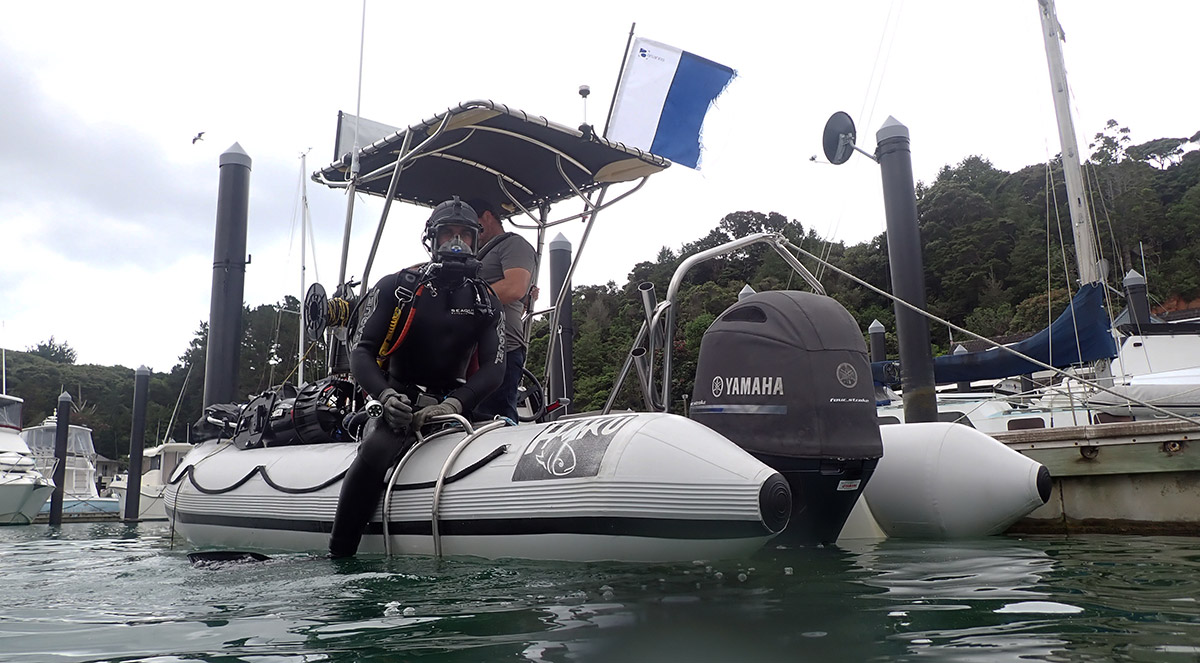Hull marine pest surveys under way
28 Sep 2022, 9:29 AM
Divers have begun a programme of checking what will be 2000-plus boat hulls by May 2023 as part of an ongoing search targeting unwanted pests threatening Northland’s marine environment.
The 2022-2023 hull inspection programme began in Houhora recently after a weak positive signal of Mediterranean fanworm (Sabella spallanzanii) was detected in an environmental DNA (eDNA) sample taken by staff during an educational event earlier in the month.
Kaeden Leonard, the Northland Regional Council’s Biosecurity Manager – Marine, says divers surveyed all 29 vessels present and found a small number of juvenile fanworm on one of them.
“Apart from the fanworm, the vessel was otherwise clean and highlights the need for vessel owners to be vigilant about applying antifouling coatings to niche areas.”
Northland-based dive contractors Marine Environmental Field Services (which carried out the surveys for the past four years) are back in the water again this season.
Mr Leonard says authorities are keen to ensure vessels are free of marine pests before owners start travelling to new areas with the onset of warmer summer weather.
One of the unwanted pests that authorities are targeting is Mediterranean fanworm which is now well-established in Whangārei Harbour.
“This year in Whangārei Harbour, if your vessel is found to be harbouring Mediterranean fanworm an inspection notice and information will be emailed to the mooring owner or marina operators so this information can be passed onto vessel owners informing them that the hull needs to be cleaned if the vessel is going to move to another designated place/harbour.”
In all other Northland harbours, a Mediterranean fanworm discovery on a vessel hull will result in a direction to haul it out for cleaning immediately (at the owner’s cost) and they may also be subject to prosecution.
“Divers will also be keeping an eye out this season for the newly-introduced invasive seaweed Caulerpa that has been detected at Great Barrier Island (Aotea) and Great Mercury Island (Ahuahu).”
“Vessel owners are asked to be extra vigilant and clean anchors and topside equipment like cray pots and ropes when moving between regions, especially after visiting known infected areas.”
Meanwhile, among a range of unwanted marine nasties the divers will be checking for on hulls and other artificial structures are a number already known to be in New Zealand.
These include Asian date mussel (Arcuatula senhousia), Australian droplet tunicate (Eudistoma elongatum), clubbed tunicate (Styela clava) and little bottles sea squirt (Clavelina oblonga).
Other unwanted species not known to be here yet, but which divers will also be vigilant for, include northern Pacific seastar (Asterias amurensis), European green crab (Carcinus maenas), Chinese mitten crab (Eriocheir sinensis) and Asian clam (Potamocorbula amurensis).
Boat owners keen to know if their boat has been inspected – and the results – are welcome to email marinebiosecurity@nrc.govt.nz
“Email your vessel name and mooring/berth location and if yours is one of the 2000-plus hulls inspected in the survey you’ll be notified.”
In addition to rules covering transportation of marine pests, council has rules limiting the amount of ‘biofouling’ (build-up of microorganisms, algae, plants and pests) vessels can be carrying when they enter new spots.
“Vessel hulls are the most common way for marine pests to hitch a ride and our Marine Pathway Management Plan aims to manage this issue.”
Under the plan, any vessel entering Northland waters or moving from one harbour to another must have no more than ‘light fouling’, defined as a slime layer and/or barnacles and a few patches of macrofouling.
“Marine pests can hitchhike and hide within boat fouling, so preventing the movement of infested vessels is the best way to stop the spread of marine invaders,” Mr Leonard says.
“If a pest species is detected, owners will be asked to haul the vessels out and clean or treat them in a timeframe appropriate to the level of risk. A $500 fine may also apply.”
Mr Leonard says it’s always worth bearing in mind that marine pests found on vessels have often been concealed in ‘niche’ areas, which require special attention when applying antifouling or during a ‘lift and wash’ period.
“We strongly recommend double-checking these niche areas, like the base of the keel, and inside intakes and bow thrusters, before your vessel goes back in the water.”
He says the regional council is very appreciative of the steps so many boaties are already taking to keep their boat hulls clean and similarly, great support from Northland’s marina operators.
“Marina operators have been requiring a receipt proving a vessel conforms to what’s been dubbed the ‘six or one’ initiative; being either antifouled within the preceding six months or having undergone a ‘lift and wash’ within the preceding month.”
He says more information on the council’s rules and requirements can be found at: www.nrc.govt.nz/marinebiosecurity and www.marinepests.nz

A file shot of Northland Regional Council marine biosecurity officer Toby Dickson about to check hulls for marine pests.
